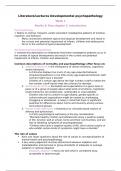Literature/Lectures Developmental psychopathology
Week 1
Parritz & Troy chapter 1: Introduction
Psychopathology
= Refers to intense, frequent, and/or persistent maladaptive patterns of emotion,
cognition, and behavior.
- Many connections between typical and atypical development and result in
the current and potential impairment of infants, children and adolescents.
- Occur in the context of typical development.
Developmental psychopathology
= extends this description to emphasize that these maladaptive patterns occur in
the context of typical development and result in the current and potential
impairment of infants, children and adolescents.
Common descriptions of normality and psychopathology often focus on:
1. Statistical deviance = the infrequency of certain emotions, cognitions
and/or behaviors.
- A child who displays too much of any age-expected behavior
(impulsivity/sadness) or too little of any age-expected behavior (self-
control) might have a disorder
- Children of a certain age above the high number cutoff or below the
low number cutoff would meet the criterion for disorder.
2. Sociocultural norms = the beliefs and expectations in a given time or
place or of a group of people about what kinds of emotions, cognitions
and/or behaviors are problematic, undesirable or unacceptable.
- Children who fail to conform to age-related, gender-specific or
culture-relevant expectations might be viewed as challenging,
struggling or disordered. keep in mind that there is significant
potential for differences about norms and diversity among various
sociocultural groups.
3. Mental health definitions = theoretical or clinically based notions of
distress and dysfunction.
- A child’s psychological well-being is the key consideration.
- “Mentally healthy children and adolescents enjoy a positive quality
of life; function well at school, home and their communities; and are
free of disabling symptoms of psychopathology”
- “Children who have a negative quality of life, who function poorly or
who exhibit certain kinds of symptoms might have a disorder”
The role of values
Each one raises questions about the role of values in conceptualization of
mental health and psychopathology.
A key value judgement involves distinctions between adaption and
maladaptation and personal or group standards of adequate or average
adaption or optimal adaption
- Adequate adaption = has to do with what is considered okay,
acceptable or good enough.
, - Optimal adaption = has to do with what is excellent, superior or “the
best of what is possible”
Rated of disorders in infancy, childhood and adolescence
The multi-part task of estimating rates of disorders includes
1) Identifying children with clinically significant distress and dysfunction,
whether or not they are in treatment.
2) Calculating levels of general categories of disorders (anxiety disorders)
and within-category type of disorders (separation anxiety disorder) and
their associated impairments.
3) Tracking changing trends in the identification and diagnosis of specific
disorders, such as ADHD or depression.
Prevalence and incidence rates are both measures of the frequency of
psychopathology.
Prevalence = refers to the proportion of a population with a disorder
Incidence = refers to the rate at which new cases arise
Holistic approaches
= are multicomponent approaches that focus on children, their families, and their
communities and systems, and are often embedded in existing health,
educational, or social networks.
Mukolo, Heflinger, and Wallston (2010) identify:
1. Several dimensions of stigma, including negative stereotypes, devaluation,
and discrimination;
2. two targets of stigma, the individual and the family; and
3. two contexts of stigma, the general public and the self/individual. Both
Mukolo and Heflinger and Hinshaw urge researchers to continue to
investigate the multiple ways that stigma complicates the experiences of
children with mental disorders and their families.
Allocation of resources, availability and accessibility of care
Parent’s/schools/communities struggle to allocate scare emotional, social
and financial resources. One continuing difficulty involves access to care.
In addition to this emergency health care is also difficult to access.
Barriers to care are widespread, persistent and have been extensively
summarized.
- Barriers related to the structure and funding of the mental health
care system include limited or poorly conceived mental health
policies, lack of provider availability, long waiter lists, lack of service
coordination, inconveniently located services, transportation
difficulties and the inability to pay and/or inadequate insurance
coverage.
- Barriers related to perceptions about mental health difficulties
include the inability to acknowledge a disorder, denial of problem
severity and beliefs that difficulties will resolve over time or will
improve without formal treatment.
- The ignorance and intolerance that contributes to the painfully
unnecessary stigmatization of individuals with psychopathology
, must be confronted in and of itself but also addressed as a barrier to
care.
The globalization of children’s mental health
Involves the recognition of children’s experiences of distress, dysfunction
and unmet needs around the globe.
Children in resource-poor locations (low- and middle-income countries) are
at higher risk for poor adaption and poor outcomes.
Lecture 1 - Fundamentals of developmental psychopathology
What is developmental psychopathology?
Psychopathology: intense, frequent, and/or persistent maladaptive
patterns of emotion, cognition, behavior.
Developmental psychopathology emphasizes that these maladaptive
patterns occur in the context of typical development and results in the
current and potential impairment of infants, children, and adolescents.
Psychopathology in the context of typical development
1. Dynamic appreciation of children’s strengths and weaknesses as they
experience salient, age-related challenges
2. Individual, familial, ethnic, cultural, societal beliefs about desirable vs
undesirable outcomes (= definition of normality)
Defining typical/normal vs atypical/abnormal
Statistical deviance (how differently the person feels/thinks/acts compared
to others)
- Issues: where is the cutoff?
- Which side of the spectrum is concerning?
Sociocultural norms (how the person is expected to think/feel/act)






